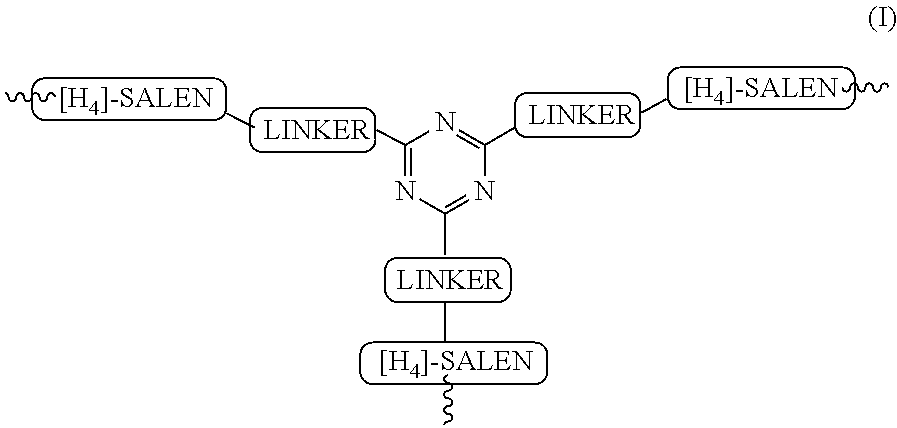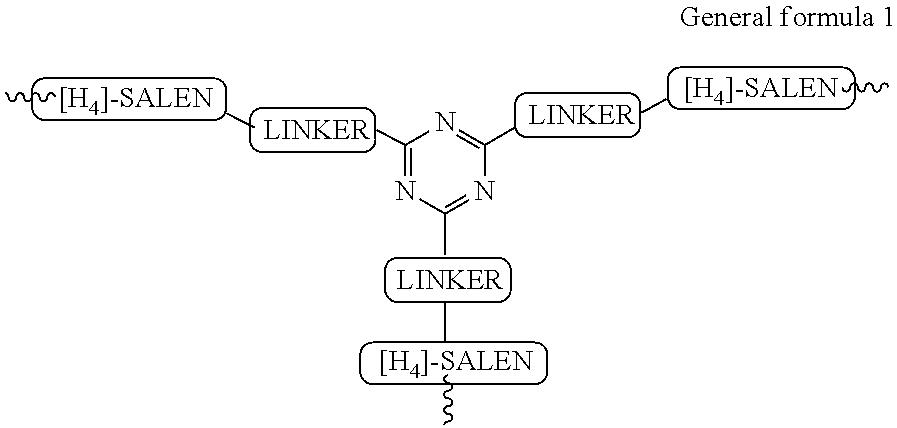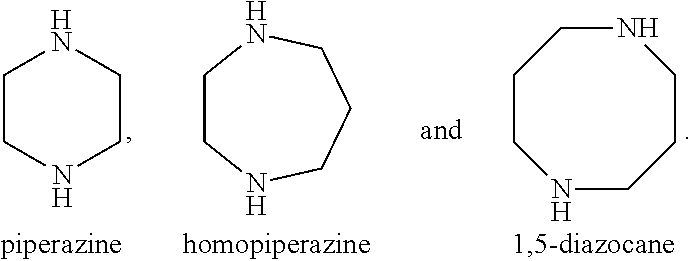Recyclable chiral catalyst for asymmetric nitroaldol reaction and process for the preparation thereof
a nitroaldol and chiral catalyst technology, which is applied in the field of recycling chiral catalysts for asymmetric nitroaldol reaction and the process for the preparation thereof, can solve the problems of catalyst non-recyclability, difficult separation of catalyst from product, and long reaction time (69-120 h) to complete, and achieves high yield, low cost, and high enantioselectivity. the effect of greater than 95%
- Summary
- Abstract
- Description
- Claims
- Application Information
AI Technical Summary
Benefits of technology
Problems solved by technology
Method used
Image
Examples
example 1
[0125]In a typical process for the preparation of asymmetric recyclable homogeneous catalyst described in following Steps:
Step 1
Tri-tert-butyl 4,4′,4″-(1,3,5-triazine-2,4,6-triyl)tris(piperazine-1-carboxylate)
[0126]In a 3 necked round-bottom flask, cyanuric chloride (10 mmol, 1.84 g) and 1-Boc piperazine (BPIP, 30 mmol, 5.59 g) was added together in 50 ml of tetrahydrofuran and stirred at room temperature 25° C. for 1 h. Diisopropylethylamine (100 mmol, 17.4 ml) was added to the reaction mixture and the resulting solution was allowed to stir for 1 h at room temperature 25° C. followed by heating to reflux at 85° C. for 16 h (checked on TLC, Rf 0.6 in 95:5 dichloromethane:methanol). After completion of reaction, the reaction mixture was allowed to cool at room temperature 27° C. and then the solvent was evaporated under vacuum. The solid thus obtained was dissolved in 100 ml of dichloromethane and washed successively with water (3×100 ml) and brine (2×100 ml). The organic layer was d...
example 2
Step 1
[0134]A solution of (1S,2S)-(+)-1,2-diaminocyclohexane (3.2 mmol, 366 mg in 10 ml of tetrahydrofuran) was added drop wise to the solution of the product obtained in step 3 of example 1 (2 mmol, 1.8 g in 10 ml of tetrahydrofuran) and the resulting mixture was allowed to reflux at 85° C. for 2 h (checked on TLC). The resulting dark yellow solution was cooled to room temperature 29° C. followed by evaporation of solvent under vacuum. The yellow solid thus obtained was washed with methanol to get the desired product (2.0 g; 98%). Anal calcd for C44H62N11O2 (single unit): C, 68.01; H, 8.04; N, 19.83. found: C, 67.92; H, 7.91; N, 19.95. IR (KBr); v: 3378, 2946, 2807, 1957, 1626, 1536 cm−1.
Step 2
[0135]1 g of the yellow crystalline solid obtained in step 1 of this example was dissolved in dry methanol:dichloromethane (4:1; 50 ml) to which 4 equivalents of sodium borohydride was added in 4 equal portions and the reaction mixture was allowed to stir at room temperature 21° C. for 10 h. ...
example 3
Step 1
[0136]A solution of (1R,2R)-(+)-1,2-diphenylethylenediamine (3.2 mmol, 678 mg in 10 ml of tetrahydrofuran) was added drop wise to the solution of the product obtained in step 3 of example 1 (2 mmol, 1.8 g in 10 ml of tetrahydrofuran) and the resulting mixture was allowed to reflux at 85° C. for 4 h (checked on TLC). The resulting dark yellow solution was cooled to room temperature 29° C. followed by evaporation of solvent under vacuum. The yellow solid thus obtained was washed with methanol to get the desired product (Yield, 2.24 g; 96%). Anal calcd for C52H64N11O2 (single unit): C, 71.37; H, 7.37; N, 17.61. found: C, 71.19; H, 7.28; N, 17.75. IR(KBr); v: 3651, 3381, 2949, 1953, 1628, 1539 cm−1.
[0137]1H NMR (CDCl3, 500 MHz) δ: 13.6-13.8 (m, 2H), 8.2-8.4 (m, 2H), 6.9-7.2 (m, 14H), 4.6-4.7 (m, 3H), 3.3-3.7 (m, 14H), 2.2-2.4 (m, 9H), 1.7 (m, 2H), 1.4-1.5 (m, 18H); 13C NMR (CDCl3, 125 MHz) δ: 30.9, 36.2, 44.5, 54.4, 64.2, 81.6, 83.8, 119.7, 129.5, 129.8, 132, 132.2, 133.3, 140.5, ...
PUM
| Property | Measurement | Unit |
|---|---|---|
| temperature | aaaaa | aaaaa |
| temperature | aaaaa | aaaaa |
| temperature | aaaaa | aaaaa |
Abstract
Description
Claims
Application Information
 Login to View More
Login to View More - R&D
- Intellectual Property
- Life Sciences
- Materials
- Tech Scout
- Unparalleled Data Quality
- Higher Quality Content
- 60% Fewer Hallucinations
Browse by: Latest US Patents, China's latest patents, Technical Efficacy Thesaurus, Application Domain, Technology Topic, Popular Technical Reports.
© 2025 PatSnap. All rights reserved.Legal|Privacy policy|Modern Slavery Act Transparency Statement|Sitemap|About US| Contact US: help@patsnap.com



